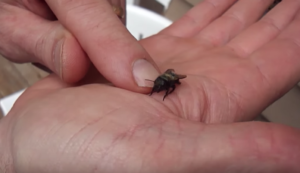Three wooden blocks appeared in our office this winter. A grid of mud packed holes graced each block. The stack was labeled “emerge March” and “Doug” with a phone number…
“Doug,” it turns out, referred to Doug Banner, a professor of Health and Community Studies at Western Washington University. A former student of ecology, with a Master of Education degree in Science, Doug has been working with orchard mason bees for more than forty years.
Doug’s granddaughter attends Whatcom Middle School. He frequently stands out in the garden while waiting to pick her up from school, and got to thinking that bees would be the perfect addition to the garden with its productive hoop house and maturing food forest.
The bees, dormant in their mud-packed holes, would emerge with the spring equinox.
Orchard mason bees are a fabulous addition to any school garden. Although they have stingers, they rarely ever sting. The bees are fuzzy and tiny — about the size of black flies — and have been wonderful to observe during Common Threads’ spring garden classes.
Over the course of several weeks this spring, Doug has generously shared his immense wealth of knowledge about bees with students.
For instance, Doug brought in remnants of a frozen bee nest, which included the eggs, larva and pupa, wrapped in a wispy cocoon. Students could see the layers of pollen and packed mud that separate each pupa. Students also learned that native North American mason bees are a lot messier than the more familiar European honey bee, which means they distribute pollen very well! 250 mason orchard bees, can pollinate an acre of apple trees at the same rate it would take at least 10,000 honey bees!
Orchard Mason bees are known for their large jaw, which enables them to chomp their way through mud wall barriers. Ten bees occupy each hole, and once the adults emerge each female finds a new hole to nest in. They live and lay eggs for their short 8 to 10 week life.
Thanks to Doug’s initiative, Common Threads has been inspired to make new bee boxes for other partner schools. We are so grateful to Doug! An interested, willing and knowledgeable volunteer can make such a difference in the lives of students!
Related story: read about mason bee house making at this year’s Spring Break Camp Honey (click here).


